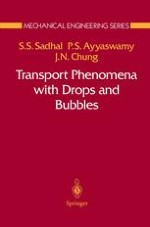1997 | OriginalPaper | Chapter
Transport at Intermediate and High Reynolds Numbers
Authors : S. S. Sadhal, P. S. Ayyaswamy, J. N. Chung
Published in: Transport Phenomena with Drops and Bubbles
Publisher: Springer New York
Included in: Professional Book Archive
Activate our intelligent search to find suitable subject content or patents.
Select sections of text to find matching patents with Artificial Intelligence. powered by
Select sections of text to find additional relevant content using AI-assisted search. powered by
Highly accurate closed-form analytical and perturbation solutions for flow description and transport are available for many low Reynolds number (creeping flow) situations where the nonlinear inertial effects are weak. However, fluid motion and transport at intermediate Reynolds numbers [Re ~ O(1) — O(100)] or even higher values are much more complicated. For example, at higher values of the translational Reynolds number, the external flow may separate as it moves toward the rear of the particle and the internal motion may also consist of secondary vortices. Under such circumstances, various transport mechanisms are set into play and the accurate determination of the magnitude of transport becomes a challenging task. Numerical and experimental studies with a drop have shown that at higher values of the Reynolds number, a recirculatory wake is formed with dimensions that are comparable to the drop size [62,63,87]. In such cases, wake effects may have to be taken into account to ascertain accurately the magnitude of transport quantities. It is well acknowledged that both analytical modeling and numerical evaluations of wake effects are in general difficult due to their elliptic nature. In such situations, we rely on semianalytical or fully numerical solutions to the governing equations. With sophisticated numerical methods and super-computers, it is possible to develop sufficiently accurate and physically realizable solutions to problems in the intermediate and high Reynolds number flow regimes.
